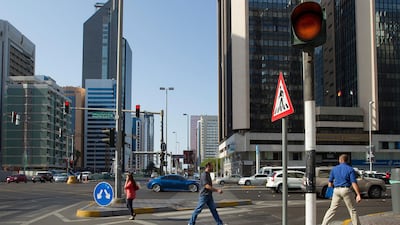If you want to live, walk. Those were the ridiculous-sounding words that captured my attention on Twitter this week, not because they're laughable, but because I have come to the same conclusion since I have lived in Abu Dhabi.
The words formed the introduction to a short film starring the Indian-American journalist Fareed Zakaria that aims to draw attention to the links between contemporary urban life and the "slow-motion emergency" that is urban diabetes.
"Cities must be designed with some capacity to walk," The Washington Post columnist and CNN frontman insists. "There are many cities in the developing world that are being built and designed in a way that it would be impossible to walk in them."
According to Cities Changing Diabetes, the organisation behind the film, two thirds of the world's 415 million diabetics live in cities, and there's a direct correlation between our health, our increasingly sedentary lifestyles and urban design.
Consequently, the thinking goes, if we change our cities, then we change our living patterns, and if we change our living patterns, this will ultimately have a positive impact on our health.
Cities Changing Diabetes is a partnership between University College London and Denmark's Steno Diabetes Centre and cities such as Copenhagen, Houston, Rome, Johannesburg, Mexico City, Shanghai, Vancouver and Tianjin – all of which are engaging in pilot projects to try to tackle the problem – but given the rates of diabetes in the UAE, I'm surprised not to see Dubai or Abu Dhabi on the list.
Figures from 2015 from the International Diabetes Federation reveal that almost 20 per cent of the population between the ages of 20 and 79 suffer with type 2 diabetes, which means that the UAE figures among the top 20 nations in the global diabetes rankings for age-adjusted prevalence.
According to the Imperial College London Diabetes Centre, the trends in the 2015 data also show that the incidence of diabetes is growing at a faster rate in the UAE than it is almost anywhere else.
A closer look at Abu Dhabi's urban fabric reveals that when it comes to getting people out on the street, the city's design isn't just car-focused; it's pedestrian unfriendly.
When rock-star urbanist Richard Florida came to teach at New York University Abu Dhabi in 2013, he told me that Abu Dhabi's city grid was one of the things that had kept the city compact and had prevented it from making the mistakes made by so many sprawling American cities – but that's only half the story.
If you compare Abu Dhabi's urban grid with Manhattan's, not only are the capital's "super blocks" 24 times larger, but they're also surrounded on all sides by major highways.
Not only do these roads discourage walking, but can also increase distances between home and work, forcing people to rely on motorised transport.
Focused as they were on creating a city that was efficient in terms of its infrastructure, it's as if Abu Dhabi's planners channelled the spirit of the now-demonised American planner Robert Moses, whose mid-century plans for a Lower Manhattan Expressway would have flattened large parts of New York's SoHo and Little Italy.
Moses's scheme to connect the Manhattan and Williamsburg bridges to the Holland Tunnel was eventually scrapped thanks to widespread public outrage and the efforts of Jane Jacobs, the campaigning journalist whose ideas about streets and city life were encapsulated in her book The Death and Life of Great American Cities (1961) and recent biographical documentary Citizen Jane: Battle for the City.
Unfortunately for Abu Dhabi, there was no Jacobs-like voice here in the 1960s and 70s when many of the plans were put in place for the city we have today, but the neighbourhood-based spirit of her urbanism did inform the thinking behind the emirate's current urban blueprint, Plan Abu Dhabi 2030.
Whether Abu Dhabi's future rests with Jacobs' way or the highway is yet to be determined, but when it comes to our health, it's clear that the shape of our city is reflected in our waistlines, and that's more than a matter of planning – it's a matter of life and death.
__________________________
READ MORE:
Changing lifestyles place expats at biggest risk from diabetes, health survey shows
A look at the many benefits of stair-climbing
When it comes to our health, every step really does matter
__________________________

